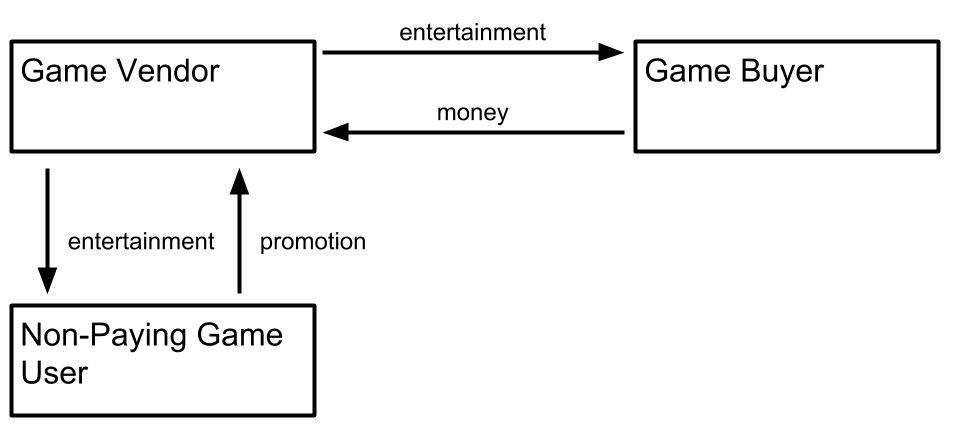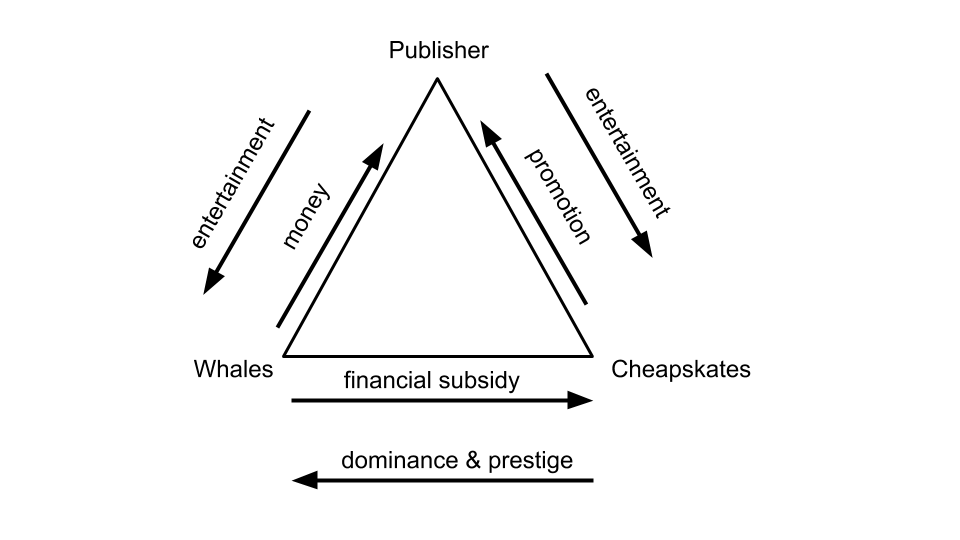F2P, Class Struggle, and the Triangle of Value
Monday, November 20, 2017
Pricing Hits the Mainstream Press!
If you like video games, you've almost certainly heard about the kerfuffle over Electronic Arts' monetization strategy for Star Wars: Battlefront II.
As it turns out, unlocking all of the game's features will require players to choose between 4,500 hours of grinding gameplay or a $2,100 deduction from their children's college funds.
I'm hardly a video game fanatic. That said, when a piece of entertainment software features a potential $2,100 price tag, you had better believe that it's going to get my attention.
Many people might not understand how free-to-play (F2P) games like Star Wars: Battlefront II are monetized. Even people who claim to be in the know typically don't fully understand the dynamics that lurk beneath the surface. So, in homage to my product manager's visual guide to feature selection, I'm going to diagram the secret of the F2P business model in glorious one-bit color.
Business Models for Games Used To Be Simple
For much of video game history, development shops had a very simple business model. Game vendors just copied the approach of most other businesses:

Transactions were structured so that one party provided value and the other party provided money. The entire business model was easy to diagram, easy to explain, and easy to understand.
Then Came Freemium
Publishers fell into a routine, and all was well. Sure, other methods popped up here and there. Expansions were sold. For a while, DLC became all the rage. Nevertheless, they were all variations upon a theme.
Eventually, freemium became mainstream. It is essentially the combination of a sales funnel and promotion method. Publishers gave away a subset of their content for free, hoping that their users would either convert into paying customers (sales funnel), attract paying customers (promotion technique), or both. Yes, some freeloaders would do neither, but they represented an acceptable cost of doing business for the vendor.

This method worked fairly well, but there was a new method on the horizon.
F2P Makes an Appearance
At first glance, free-to-play business models look an awful lot like freemium ones. On closer inspection, there are some very subtle differences.
The key is in intention. While companies using freemium try to attract a large number of customers who pay publishers some money, free-to-play is centered upon attracting a small number of whales who are willing to spend a lot of money. Interestingly, this change in corporate goals eliminates the possibility of freeloaders. To understand why, we need a more complex model.
The F2P Triangle of Value
The truth is that our models so far have only involved a single exchange:
- A publisher provides entertainment to players.
- Players provide something of value to publishers.
The F2P model requires three distinct sets of interactions between three major stakeholders:
- The publisher
- Gamers who buy a lot of content (whales)
- Gamers who buy little to no content (cheapskates)
Here's what I came up with to describe the multiplayer variety of F2P games. I call my model the F2P Triangle of Value:

Some of this model is a rehash of what we've already seen in the freemium model.
- As before, the publisher provides entertainment to its users (whales and cheapskates).
- The whales provide money to the publisher.
- The cheapskates attract other players.
One crucial point to note is that whales receive extra value from the game's publisher. This bonus is often in the form of power-ups or loot boxes. Players who don't open their wallets are immediately put at a disadvantage when compared to their spendthrift compatriots.
This single point allows for a crucial interaction required for many successful F2P business models. I'm speaking, of course, about the interaction between the cheapskates and the whales.
F2P Needs Whales and Cheapskates
In F2P games, cheapskates are far from being mere leeches upon the system (as they would be under freemium models). Non-paying players provide an important resource that is essential to a whale's happiness: themselves. Each dollar "invested" by a whale increases his relative prestige and ability to dominate those who are unwilling to part with their cash.
Without a steady supply of cheapskates, the relative value of in-game purchases would plummet. Loot boxes and the like would shift from a basis for prestige and power within the game to a means of merely keeping up with the Joneses - and that's no fun at all!
On the other hand, the cheapskates get something from the whales in return. Although direct payments to cheapskates is a largely unexplored avenue for F2P systems, it is undeniable that whales provide an essential subsidy for cheapskates. Without whales, there would be no free entertainment flowing from publisher to the cheapskates.
Balance Must Be Maintained
An F2P publisher needs to manage the three relationships depicted on the triangle as effectively as possible to maintain a successful platform.
Providing entertainment is nothing new for businesses and has been written about extensively. The real difficulty is managing the balance of power between whales and cheapskates.
If a sizable percentage of cheapskates were to rival the whales in terms of in-game dominance and power, the whales would stop paying and the subsidies for non-paying users would soon end. This would lead to the demise of the platform. Dominance can even be observed when whales and players don't compete; differentiation through required levels of grinding can often prove sufficient.
On the other hand, if whales were to dominate their non-paying rivals too easily and too often, cheapskates would see little point to taking part in the game. Yes, a small number might convert themselves into whales, but most would simply leave the system. As the game's population increasingly became whales, the value of each dollar spent would yield little in the way of increased dominance over the masses. As a result, many whales would simply seek greener pastures in other F2P franchises that featured a larger number of cheapskates available to be dominated.
This delicate balance is difficult to manage in the abstract, but it becomes even more complex in the real world. There is often a strong corporate push to maximize short-term profits. As a result, whales are often allowed to purchase extraordinary advantages (at extraordinary prices). As discussed, this may ultimately decimate the supply of cheapskates and lead to reduced income over the long term, but the resulting costs to the publisher (and damage to his reputation) will not be visible for some time.
Brilliant Conclusion
As a consumer, I'm not a fan of the free-to-play concept. I much prefer the older and straightforward business models that aligned the interests of buyer and seller without complication.
That said, F2P has proven itself to be both a lucrative and sustainable approach for a variety of publishers. The key for F2P vendors is to balance and closely monitor the three sides of the triangle of value and to ensure that each party is receiving something that it desperately wants while providing something of value in return.
Shameless Commercial Plug
Are you having trouble with your monetization strategy? Why not contact me for a consult? Or, you could take part in one of my other monetization strategies and buy one of my books.